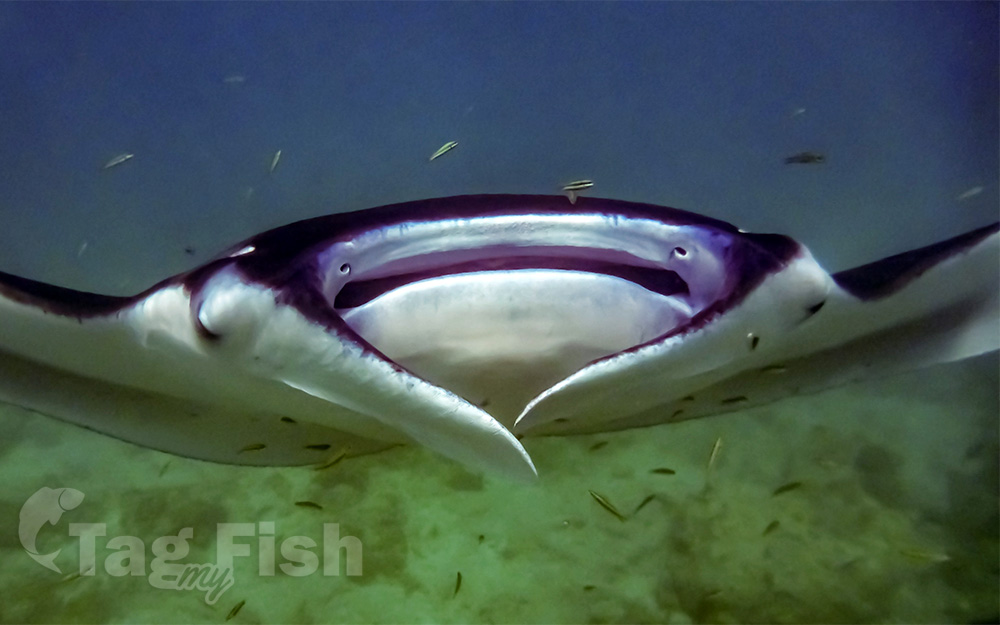Reef manta ray
(Mobula alfredi)

Classification
General data
The reef manta ray (Mobula alfredi) is a species of ray in the family Mobulidae, one of the largest rays in the world. Among generally recognized species, it is the second-largest species of ray, only surpassed by the giant oceanic manta ray (a currently unrecognized species from the Caribbean region also appears to be larger than the reef manta ray).
Reef manta rays are typically 3 to 3.5 m (9.8 to 11.5 ft) in disc width, with a maximum size of about 5.5 m (18 ft). For a long time included in M. birostris, the status of the reef manta ray as a separate species was only confirmed in 2009. The reef manta ray is found widely in the tropical and subtropical Indo-Pacific, but with a few records from the tropical East Atlantic and none from the West Atlantic or East Pacific. Compared to the giant oceanic manta ray, the reef manta ray tends to be found in shallower, more coastal habitats, but local migrations are sometimes reported. Mobula birostris is similar in appearance to Mobula alfredi and the two species may be confused as their distribution overlaps. However, there are distinguishing features.
Description
The reef manta ray can grow to a disc size of up to 5 m (16 ft) but average size commonly observed is 3 to 3.5 m (11 ft). It is dorsoventrally flattened and has large, triangular pectoral fins on either side of the disc. At the front, it has a pair of cephalic fins which are forward extensions of the pectoral fins. These can be rolled up in a spiral for swimming or can be flared out to channel water into the large, forward-pointing, rectangular mouth when the animal is feeding. The eyes and the spiracles are on the side of the head behind the cephalic fins, and the five gill slits are on the ventral (under) surface. It has a small dorsal fin and the tail is long and whip-like. The manta ray does not have a spiny tail as do the closely related devil rays (Mobula spp.). The color of the dorsal side is dark black to midnight blue with scattered whitish and greyish areas on the top head. The ventral surface is white, sometimes with dark spots and blotches. The markings can often be used to recognize individual fish. Mobula alfredi is similar in appearance to Mobula birostris and the two species may be confused because their distribution overlaps. However, there are distinguishing features.
Physical distinctions between oceanic manta ray and reef manta ray
The first difference could be the size because the giant oceanic manta ray is bigger than the reef manta ray, 4 to 5 m (13–16 ft) on average versus 3 to 3.5 m (9.8–11.5 ft) on average. However, if the observed rays are young, their size can easily bring confusion. Only the color pattern remains a fast and effective way to distinguish them. The reef manta ray has a dark dorsal side with usually two lighter areas on top of the head, looking like a nuanced gradient of its dark dominating back coloration and whitish to greyish, the longitudinal separation between these two lighter areas forms a kind of Y. While for the oceanic manta ray, the dorsal surface is deep dark and the two white areas are well marked without gradient effect. The line of separation between these two white areas form meanwhile a T.
Differences can also be made by their ventral coloration, the reef manta ray has a white belly with often spots between the branchial gill slits and other spots spread across the trailing edge of pectoral fins and abdominal region. The oceanic manta ray has also a white ventral coloration with spots clustered around the lower region of its abdomen. Its cephalic fins, inside of its mouth, and its gill slits are often black.
Distribution and habitat
The reef manta ray has a widespread distribution in tropical and subtropical parts of the Indo-Pacific, with few records from the warm East Atlantic and none in the West Atlantic or East Pacific. It can be observed in several often-visited regions such as Hawaii, Fiji, French Polynesia, Micronesia, Bali, Komodo, Maldives, Mozambique, Australia and the Philippines. It is primarily found in coastal regions.
Reef manta rays live in a more or less identical wide area with the possibility of short migration to follow the zooplankton. They, therefore, have a relatively sedentary behavior with precise areas for cleaning and feeding still within close proximity of coasts, reefs, or islands.











